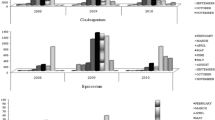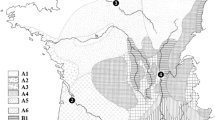Abstract
Cladosporium conidia have been shown to be important aeroallergens in many regions throughout the world, but annual spore concentrations vary considerably between years. Understanding these annual fluctuations may be of value in the clinical management of allergies. This study investigates the number of days in summer when spore concentration exceeds the allergenic threshold in relation to regional temperature and precipitation at two sites in England and Wales over 27 years. Results indicate that number of days in summer when the Cladosporium spores are above the allergenic concentration is positively correlated with regional temperature and negatively correlated with precipitation for both sites over the study period. Further analysis used a winter North Atlantic Oscillation index to explore the potential for long-range forecasting of the aeroallergen. For both spore measurement sites, a positive correlation exists between the winter North Atlantic Oscillation index and the number of days in summer above the allergenic threshold for Cladosporium spore concentration.



Similar content being viewed by others
References
Anon (2002) Fin Pollen Bull (Suppl) 26:2
Barnes C, Tuck J, Simon S, Pacheco F, Hu F, Portnoy J (2001) Allergenic materials in the house dust of clinical patients. Ann Allergy Asthma Immunol 86:517–523
Barrow EM, Hulme M (1996) Changing probabilities of daily temperature extremes in the UK related to future global warming and changes in climate variability. Clim Res 6:21–31
Brown HM, Jackson FA (1978) The value of aerobiology to an allergy treatment centre. In: Federal Environmental Agency (eds) Proceedings of the First International Conference on Aerobiology, Munich, 13–15 August. Erich Schmidt, Berlin, pp 278–286
Davies RR, Denny MJ, Newton LM (1963) A comparison between summer and autumn air spores at London and Liverpool. Acta Allergol 28:131–147
Frankland AW, Davies RR (1965) Allergie aux spores de moisissures en Angleterre. Poumon Coeur 21:11–23
Gravesen G (1979) Fungi as a cause of allergic disease. Allergy 34:134–154
Hirst JM, Hurst GW (1967) Long-distance spore transport. In: Gregory PH, Monteith JL (eds) Airborne microbes. Symposium of the Society of General Microbiology 17. Cambridge University press, Cambridge, pp 307–344
Hjelmroos M (1993) Relationship between airborne fungal spore presence and weather variables. Grana 32:40–47
Hurrell JW, Van Loon H (1997) Decadal variations in climate associated with the North Atlantic Oscillation. Clim Change 36:301–326
Katial RK, Zhang Y, Jones RH, Dyer PD (1997) Atmospheric mold spore counts in relation to meteorological parameters. Int J Biometerol 41:17–22
Kettlewell PS, Stephenson DB, Atkinson MD, Hollins PD (2003) Summer rainfall and wheat grain quality: relationships with the North Atlantic Oscillation. Weather 58:155–164
Kurkela T (1997) The number of Cladosporium conidia in the air in different weather conditions. Grana 36:54–61
Lewis SA, Corden JA, Forster GE, Newlands M (2000) Combined effects of aerobiological pollutants, chemical pollutants and meteorological conditions on asthma admissions and A & E attendances in Derbyshire UK, 1993–96. Clin Exp Allergy 30:1724–1732
Manley G (1974) Central England temperatures: monthly means 1659 to 1973. Q J R Meteorol Soc 100:389–405
Molina AN, Romero JA, Garcia-Pantaleón FI, Comtois P, Vilches ED (1998) Preliminary statistical modelling of the presence of two conidial types of Cladosporium in the atmosphere of Cordoba, Spain. Aerobiologia 14:229–234
Ottersen G, Planque B, Belgrano A, Post E, Reid PC, Stenseth NC (2001) Ecological effects of the North Atlantic Oscillation. Oecologia 128:1–14
Parker DE, Legg TP, Folland CK (1992) A new daily central England temperature series. Int J Climatol 12:317–342
Quian B, Saunders MA (2003) Summer UK temperature and its links to preceding Eurasian snow cover, North Atlantic SSTs and the NAO. J Clim (in press)
Rich S, Waggoner PE (1962) Atmospheric concentration of Cladosporium spores. Science 137:962–965
Rogers JC (1984) The association of the North Atlantic Oscillation and the Southern Oscillation in the Northern Hemisphere. Mon Weather Rev 112:1999–2015
Stephenson DB, Paven P, Bojariu R (2000) Is the North Atlantic Oscillation a random walk? Int J Climatol 20:1–18
Wedgebrow CS, Wilby RL, Fox HR, O'Hare G (2002) Prospects for seasonal forecasting of summer drought and low river flow anomalies in England and Wales. Int J Climatol 22:219–236
Wigley TML, Lough JM, Jones PD (1984) Spatial patterns of precipitation in England and Wales and a revised, homogeneous England and Wales precipitation series. J Climatol 4:1–25
Wilby RL, O'Hare G, Barnsley N (1997) The North Atlantic Oscillation and British Isles climate variability, 1865–1996. Weather 52:266–275
Acknowledgements
We thank the Midlands Asthma and Allergy Research Association (MAARA) for funding long term aerobiological research.
Author information
Authors and Affiliations
Corresponding author
Rights and permissions
About this article
Cite this article
Hollins, P.D., Kettlewell, P.S., Atkinson, M.D. et al. Relationships between airborne fungal spore concentration of Cladosporium and the summer climate at two sites in Britain. Int J Biometeorol 48, 137–141 (2004). https://doi.org/10.1007/s00484-003-0188-9
Received:
Accepted:
Published:
Issue Date:
DOI: https://doi.org/10.1007/s00484-003-0188-9




